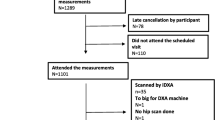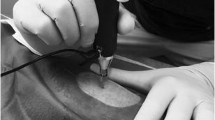Abstract:
Bone mass and structure at the proximal femur are important predictors of hip fracture. The aims of this study were to compare in a large sample of elderly men and women the precision of measurements of bone mass and structure at multiple sites at the proximal femur, to examine their interrelationships, to establish their relationships with age and body size, and to examine criteria for defining geometric and architectural variables in bone structure. Women (n= 336) and men (n= 141) over the age of 60 years were studied cross-sectionally. Bone mineral density (BMD) and content (BMC) at the proximal femur were measured in duplicate by dual-energy X-ray absorptiometry (DXA). Shaft and total upper femur (hip) sites in addition to femoral neck, Ward's triangle and trochanter were measured. Structural variables, measured from radiographs and from DXA images, including cortical thickness at calcar femorale, lateral cortex and mid-femur, width of the femur and medulla, Singh grade, hip and femoral axis length, femoral head and neck width and the center of mass of the femoral neck. BMD and BMC had high reproducibility and there were significant differences in reproducibility across sites. Among sites, total upper femur and shaft had the highest reproducibility. Duplicate measurements substantially improved reliability of the measurement and are recommended when the value is close to a diagnostic level or when it will be used to establish rates of change. Reproducibility of structural variables was also high except for the lateral cortex, center of mass and Singh grade. Variance due to measurement error did not change with either age or gender. Women were significantly different from men, after controlling for differences in body size, in all variables except Singh grade and medulla width. BMD and BMC were negatively related to age and positively to body size. Structural variables examined in relation to age and body size fell into two categories. The first comprised variables that were not age-related but were body-size-related, suggesting that they could be classified as geometric variables. The second comprised variables that were both body-size-related and age-related, suggesting that they could be classified as architectural variables. Using these criteria, calcar and lateral cortex were architectural variables, whereas shaft width, hip and femoral axis length, femoral head and neck width, and center of mass were geometric in both men and women. In women, shaft cortex width and medulla width were age-related, whereas in men they were not. Singh grade showed no consistent pattern with age or body size in women and men.
Similar content being viewed by others
Author information
Authors and Affiliations
Additional information
Received: 7 January 1997 / Accepted: 7 November 1997
Rights and permissions
About this article
Cite this article
Peacock, M., Liu, G., Carey, M. et al. Bone Mass and Structure at the Hip in Men and Women over the Age of 60 Years . Osteoporos Int 8, 231–239 (1998). https://doi.org/10.1007/s001980050059
Issue Date:
DOI: https://doi.org/10.1007/s001980050059




